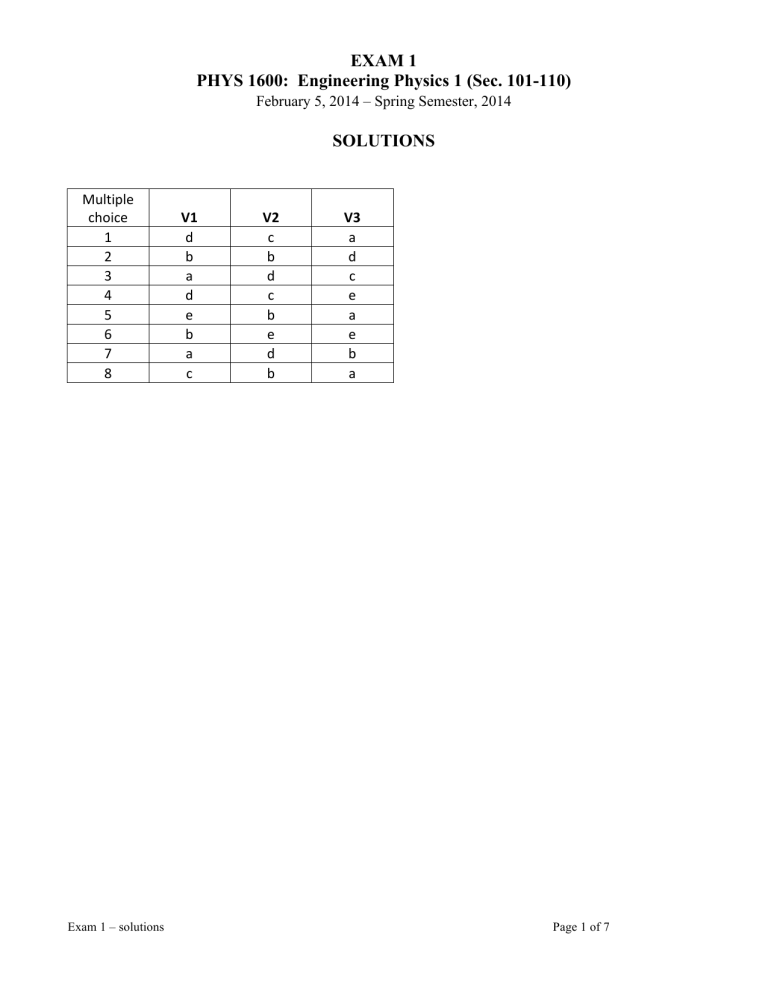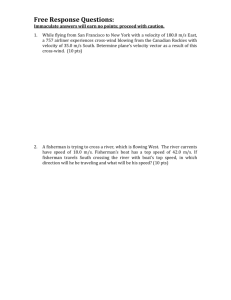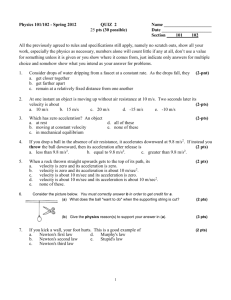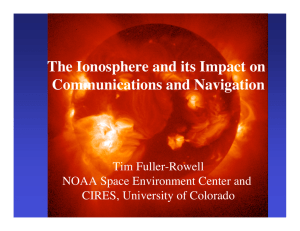EXAM 1 PHYS 1600: Engineering Physics 1 (Sec. 101

Multiple choice
3
4
1
2
7
8
5
6
V1 d b a d a c e b
EXAM 1
PHYS 1600: Engineering Physics 1 (Sec. 101-110)
February 5, 2014 – Spring Semester, 2014
SOLUTIONS
V2 c b d c b e d b
V3 a d c e b a a e
Exam 1 – solutions Page 1 of 7
Part 1: Problems 1 through 11 (5 pts each – 55 pts. total) Short Answer and Multiple Choice Problems
For multiple choice: Circle your answer AND write your answer on the front page
Problems 1 - 3 use the following figures.
(a) (b) (c) (d)
DIFFERENT SETUPS FOR EACH EXAM – Please check your version!
1) Which plot shows position vs. time of a car that is moving backwards at a constant speed.
2) Which plot shows velocity vs. time of car initially moving backward, but with a positive acceleration.
3) Which plot shows position vs. time of a car coming to rest at a stoplight.
____________________________________________________________________________________
4) In interplanetary space, a small probe has to make a course correction. If it is initially traveling at
350 m/s i and can fire its thrusters to produce an acceleration of 1.2 m/s 2 , how long would it need to fire its engines in the y-direction to have a speed of 400 m/s. v
= v x
2
+ v y
2
SPEED = magnitude of velocity => so : v y
= v 2
− v x
2 and : v y
= v yi
+ a y t → t = v y a y
P4 v x
(m/s)
|v| (m/s) a v y y
(m/s t (s)
2
(m/s)
)
V1
350
400
1.2
194
161
V2
300
375
1.2
225
187.5
V3
250
325
1.2
208
173
Exam 1 – solutions Page 2 of 7
Problems 5 and 6 use the following figure:
140
120 c
100
1"
80 b
60
2"
40 d
20 a
3"
0
0 20 40 60 80 100 120
4"
horizontal position (m)
DIFFERENT SETUPS FOR EACH EXAM – Please check your version!
5,"zero"
5) At point b , the directions of the velocity and acceleration ( v , a ) are represented by which vectors?
6) At point c , the directions of the velocity and acceleration ( v , a ) are represented by which vectors?
Problems 7 & 8 use the following information. The trajectory of a small ball rolling across a floor is given by:
V1 V2 V3
a x a y v x v y
( ) =
( t 2
−
3 ) i ˆ
+
"
$
#
4 t
−
2t
4-‐t
2
-‐1
1
2 t 2
%
'
& j ˆ ( ) =
( 2 t
7) The magnitude of the acceleration of the ball is:
2
−
3 )
4t
4-‐t
4
-‐1 i ˆ
+
"
$
#
4 t
−
1
2 t 2
%
'
& j ˆ ( ) =
( 3 t 2
−
3 ) i ˆ
+
"
$
#
4 t
−
6t
4-‐t
6
-‐1
1
2 t 2
%
'
& j ˆ a
= a x
2
P7 a (m/s 2 )
+ a 2 y
V1
2.24
V2
4.12
V3
6.08
8) The x-component of the velocity at t = 1.5 sec:
P8 t (s)
Term: v x v y
(m/s)
(m/s)
V1
1.5 vx
3
2.5
V2
1.5 vy
6
2.5
V3
1.5 vx
9
2.5
Exam 1 – solutions Page 3 of 7
Problems 9 to 11 use the following information: (6 pts each)
Three force vectors (units of Newtons, N) are applied to an object as shown in the figure below. We seek to determine the properties of the force F
1
such that the total force will be in the horizontal direction. The magnitudes of the forces and the angle are given below.
F
3
#
F
1
= ?
F
F
3
2
= 20 N
= 8 N
F
4
= 6 N
θ = 37˚
F
4
#
9) Find the vertical component of the force F
1
(F
1y
): ______________ N
F
2
#
θ"
F
1
#
F total − y
=
0
=
F
1 y
+
F
2 y
+
F
3 y
+
F
4 y where: F
So: F
1 y
4 y
= 0 (horizontal force); F
2 y
is negative (downward) and F
3 y
is positive (upward)
= − F
2 y
− F
3 y
10) Find the magnitude of the force F
1
: ______________ N
P10
P11
P9
F
1 y
=
F
1 cos θ
F
1 y F
1
= cos θ
11) Write the total force vector on the object in terms of unit vectors: _________________________
We already know that F total-y
= 0
F
2
(-‐y)
F
3
F
4
(+y)
(-‐x) angle
F1y
F
1
(N)
F
1x
(N)
F net
(N)
V1
-‐20
8
-‐6
37 (corrected)
12
15
9.04
3.04
i + 0 j
V2
-‐20
10
-‐6
37
10
12.5
7.54
1.54
i + 0 j
V3
-‐20
15
-‐6
60
5
10.0
8.66
2.66
i + 0 j
Exam 1 – solutions Page 4 of 7
Extended Problem 1 (16 pts)
A car accelerates at a = -1 m/s 2 along a long straight road. It passes two marks that are 10 m apart at times t = 4 sec and t = 5 sec. What is the car’s velocity at t = 0 sec?
To solve, set up the problem twice at each time that is given:
At
At t t a b
:
: x x fa fb
= x ia
= x ib
+ v ia t a
+ v ib t b
+
+
1
2
2
1 a a t a a b t b
2
2
But, the initial position, velocity and the acceleration are the same for both conditions:
At
At t t a b
: x fa
: x fb
= x i
= x i
+ v i t a
+ v i t b
+
+
1 at
2
1
2 at b
2
2 a
And, we know that between two times, the change is position is given:
∆ x = x fb
− x fa
=
"
$
# x i
+ v i t b
+
1
2 at b
2
%
' −
&
"
$
# x i
+ v i t a
+
1
2 at a
2
%
'
&
∆ x = v i
( t b
− t a
) +
Then, solve for v i
1
2
: a t ( 2 b
− t 2 a
)
∆ x − v i
=
∆x (m) a (m/s 2 ) t b t a v i
(s)
(s)
(m/s)
(
1
2 t b a t b
− t
( a
)
2
− t a
2 )
V1
10
-‐1
5
4
14.5
V2
20
-‐2
5
4
29
V3
8
-‐3
5
4
21.5
Exam 1 – solutions Page 5 of 7
Extended Problem 2 (26 pts)
A supply plane is carrying relief supplies for doctors that are intended to land in their camp. The plane will fly in horizontally at a speed of 120 m/s, release the supplies, and then pull out at an angle of 30˚.
The supply package cannot hit the ground with a speed in excess of 140 m/s.
Find the following: a) The vertical velocity of the package the instant before it hits the ground. [8 pts]
Max speed sets the magnitude of the velocity the instant before it hits the ground. We know v x
is constant (projectile motion criterion) v max
= v 2 fx
+ v 2 fy v fy
= v 2 max
− v x
2
Vertical velocity is the “negative” solution. b) The total time the package is in the air. [8 pts]
With knowledge of v fy
, we can solve for time: v fy
= v iy
+ a y t t = v fy
− v iy a y
= v fy
− g c) Initial vertical height of the plane. [5 pts]
Use: y f
= y i
+ v iy t
+
1
2 a y t 2
→
0
= y i
−
1
2 gt 2 y i
=
1
2 gt 2 d) Horizontal distance from the doctors at which the package must be released. [5 pts]
Use: x f
= x i
+ v ix t +
1
2 a x t 2
→ x f
= v ix t
Exam 1 – solutions Page 6 of 7
b c d
Initial conditions:
Setup x i x f
(m)
(m) v ix
(m/s) v fx a x
(m/s)
(m/s 2 ) v iy v fy a y y y i
(m) f
(m)
(m/s)
(m/s)
(m/s 2 ) t (s)
a
Solutions
V1
0
?
120
120
0
?
0
0 m/s
?
-‐g = -‐9.8 m/s2
?
V2
0
?
80
80
0
?
0
0 m/s
?
-‐g = -‐9.8 m/s2
? v v
v x
(m/s) max
(m/s) y
=sqrt[v max
V1
120
2 -‐v
140 x
2 ] (m/s) -‐72 t = -‐v y y x f
= v ix
/g f
= (1/2)gt t
2
7.4
265
883
V3
0
?
90
90
0
?
0
0 m/s
?
-‐g = -‐9.8 m/s2
?
V2
80
100
-‐60
6.1
184
490
V3
90
120
-‐79
8.1
321
729
Exam 1 – solutions Page 7 of 7







